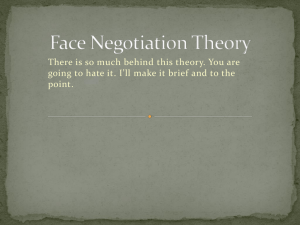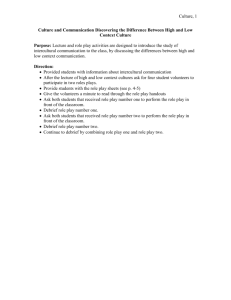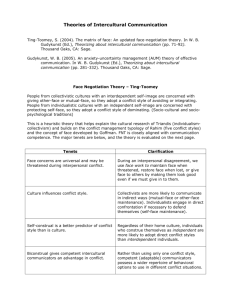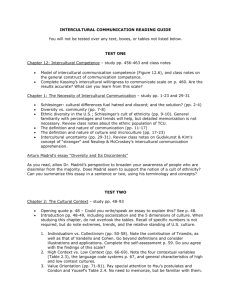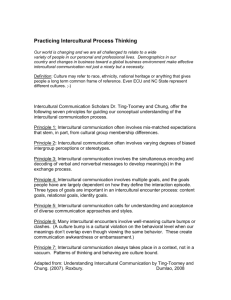Theory Reflections: Face-Negotiation Theory
advertisement
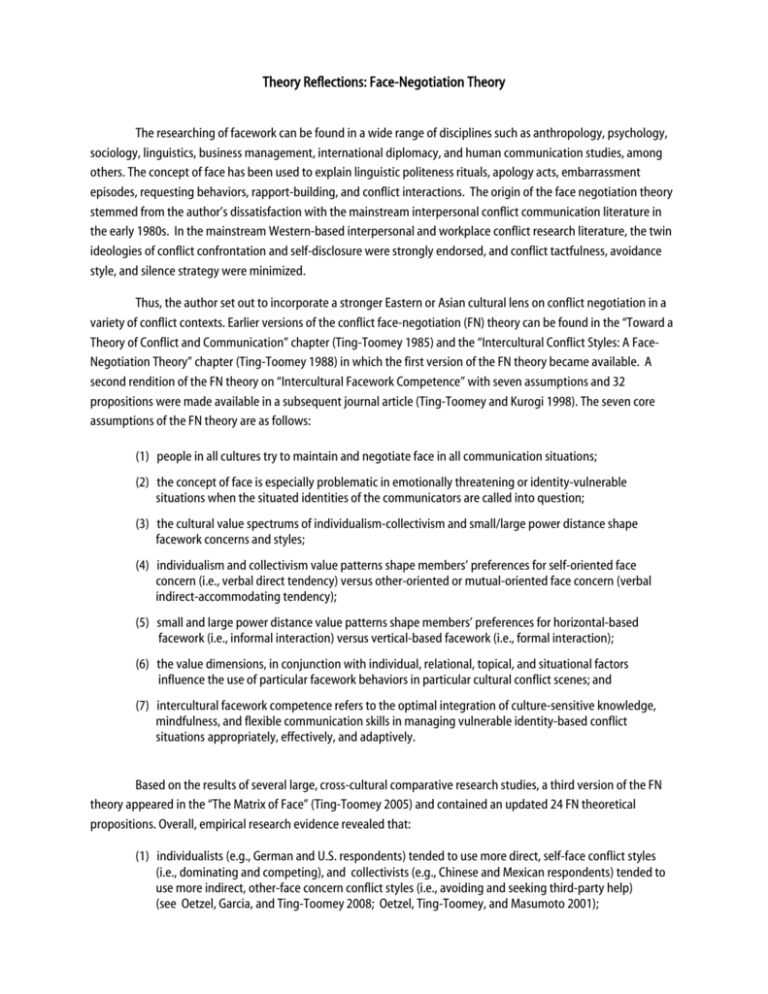
Theory Reflections: Face-Negotiation Theory The researching of facework can be found in a wide range of disciplines such as anthropology, psychology, sociology, linguistics, business management, international diplomacy, and human communication studies, among others. The concept of face has been used to explain linguistic politeness rituals, apology acts, embarrassment episodes, requesting behaviors, rapport-building, and conflict interactions. The origin of the face negotiation theory stemmed from the author’s dissatisfaction with the mainstream interpersonal conflict communication literature in the early 1980s. In the mainstream Western-based interpersonal and workplace conflict research literature, the twin ideologies of conflict confrontation and self-disclosure were strongly endorsed, and conflict tactfulness, avoidance style, and silence strategy were minimized. Thus, the author set out to incorporate a stronger Eastern or Asian cultural lens on conflict negotiation in a variety of conflict contexts. Earlier versions of the conflict face-negotiation (FN) theory can be found in the “Toward a Theory of Conflict and Communication” chapter (Ting-Toomey 1985) and the “Intercultural Conflict Styles: A FaceNegotiation Theory” chapter (Ting-Toomey 1988) in which the first version of the FN theory became available. A second rendition of the FN theory on “Intercultural Facework Competence” with seven assumptions and 32 propositions were made available in a subsequent journal article (Ting-Toomey and Kurogi 1998). The seven core assumptions of the FN theory are as follows: (1) people in all cultures try to maintain and negotiate face in all communication situations; (2) the concept of face is especially problematic in emotionally threatening or identity-vulnerable situations when the situated identities of the communicators are called into question; (3) the cultural value spectrums of individualism-collectivism and small/large power distance shape facework concerns and styles; (4) individualism and collectivism value patterns shape members’ preferences for self-oriented face concern (i.e., verbal direct tendency) versus other-oriented or mutual-oriented face concern (verbal indirect-accommodating tendency); (5) small and large power distance value patterns shape members’ preferences for horizontal-based facework (i.e., informal interaction) versus vertical-based facework (i.e., formal interaction); (6) the value dimensions, in conjunction with individual, relational, topical, and situational factors influence the use of particular facework behaviors in particular cultural conflict scenes; and (7) intercultural facework competence refers to the optimal integration of culture-sensitive knowledge, mindfulness, and flexible communication skills in managing vulnerable identity-based conflict situations appropriately, effectively, and adaptively. Based on the results of several large, cross-cultural comparative research studies, a third version of the FN theory appeared in the “The Matrix of Face” (Ting-Toomey 2005) and contained an updated 24 FN theoretical propositions. Overall, empirical research evidence revealed that: (1) individualists (e.g., German and U.S. respondents) tended to use more direct, self-face conflict styles (i.e., dominating and competing), and collectivists (e.g., Chinese and Mexican respondents) tended to use more indirect, other-face concern conflict styles (i.e., avoiding and seeking third-party help) (see Oetzel, Garcia, and Ting-Toomey 2008; Oetzel, Ting-Toomey, and Masumoto 2001); (2) layered differentiations also existed in facework patterns and conflict styles in different U.S. ethnic groups—depending on cultural/ethnic identity belongingness issues in a pluralistic society (Ting-Toomey, Yee-Jung, and Shapiro et al. 2000); (3) individuals with independent self-construal personality types tended to use self-face concern defensive conflict strategies and that interdependent self types tended to use avoiding and obliging conflict tactics (Oetzel and Ting-Toomey 2003; Ting-Toomey, Oetzel, and Yee-Jung 2001); (4) individualists tended to emphasize content problem-solving compromise, and that collectivists tended to value long-term, give-and-take relational concessions and counter-concessions; and (5) situational factors such as ingroup-outgroup and status difference have a profound impact on various facework behavioral expectations and conflict styles (Ting-Toomey 2010; Ting-Toomey and Takai 2006). Intercultural facework competence is about the mindful and creative management of emotional frustrations due primarily to cultural or ethnic group membership identity differences (Ting-Toomey 2004, 2007, 2009). It means having the necessary culture-based knowledge and ethno-relative attitude in making the commitment to interpreting the conflict communication process from an alternative cultural viewfinder. It means paying exquisite attention to identity-related back-and-forth negotiation and respect/disrespect issues. Mindful facework transformation process refers to the incremental awakening process of being in touch with our filtered senses and realizing our reactive senses and cultural worldviews shape our gut-level conflict reactions. It also means our willingness to take the time to step into the mindset and the heart-set of our conflict opponents and seeing and sensing things from their conflict lenses. Elastic conflict communication skills such as cultural-de-centering, mindful listening, empathetic resonance, mindful reframing, adaptive code-switching, and mutual-face dialogue skills are some of the face-sensitive behaviors that all administrators, staff members, faculty, and international and American students can practice in order to arrive at a common-interest process and a common-interest conflict outcome. – Stella Ting-Toomey Bibliography Oetzel, John, Adolfo J. Garcia, and Stella Ting-Toomey. 2008. “An Analysis of the Relationships Among Face Concerns and Facework Behaviors in Perceived Conflict Situations: A Four-Culture Investigation.” International Journal of Conflict Management 19, 4: 382-403. Oetzel, John G., and Stella Ting-Toomey. 2003. “Face Concerns in Interpersonal Conflict: A Cross-Cultural Empirical Test of the Face-Negotiation Theory.” Communication Research 30:599-624. Oetzel, John G., Stella Ting-Toomey, Tomoko Masumoto, Yumiko Yokochi, Xiaohui Pan, Jiro Takai, and Richard Wilcox. 2001. “Face Behaviors in Interpersonal Conflicts: A Cross-Cultural Comparison of Germany, Japan, China, and the United States.” Communication Monographs 68, 3:235-258. Ting-Toomey, Stella. 1985. “Toward a Theory of Conflict and Culture. “ In Communication, Culture, and Organizational Processes, eds. William B. Gudykunst, Leah B. Stewart, and Stella Ting-Toomey. pp. 71-86. Beverly Hills, CA: Sage. Ting-Toomey, Stella. 1988. “Intercultural Conflicts: A Face-Negotiation Theory.” In Theories in Intercultural Communication, eds. Young Yun Kim and William B. Gudykunst. pp. 213–235. Newbury Park, CA: Sage. Ting-Toomey, Stella. 2004. “Translating Conflict Face-Negotiation Theory into Practice. “ In Handbook of Intercultural Training, 3rd edition, eds. Dan Landis, Janet M. Bennett, and Milton J. Bennett. pp. 217-248. Thousand Oaks, CA: Sage. Ting-Toomey, Stella. 2005. “The Matrix of Face: An Updated Face-Negotiation Theory.” In Theorizing about Intercultural Communication, ed. William B. Gudykunst. pp. 71-92. Thousand Oaks, CA: Sage. Ting-Toomey, Stella. 2007. “Intercultural Conflict Training: Theory-Practice Approaches and Research Challenges.” Journal of Intercultural Communication Research 36, 3: 255-271. Ting-Toomey, Stella. 2009. “Intercultural Conflict Competence as a Facet of Intercultural Competence Development: Multiple Conceptual Approaches.” In The Sage Handbook of Intercultural Competence, ed. Darla K. Deardorff. pp. 100-120. Thousand Oaks, CA: Sage. Ting-Toomey, Stella. 2010. “Intercultural Mediation: Asian and Western Conflict Lens.” In International and Regional Perspectives on Cross-Cultural Mediation, eds. Dominic Busch, Claude-Helène Mayer, and Chrisitian M. Boness. pp. 79-98. Frankfurt am Main, Germany: Peter Lang. Ting-Toomey, Stella, and Atsuko Kurogi. 1998. “Facework Competence in Intercultural Conflict: An Updated FaceNegotiation Theory.“ International Journal of Intercultural Relations 22, 2:187-225. Ting-Toomey, Stella, John Oetzel, and Kimberlie Yee-Jung. 2001. “Self-Construal Types and Conflict Management Styles.” Communication Reports 14, 2:87-104. Ting-Toomey, Stella, and Jiro Takai. 2006. “Explaining Intercultural Conflict: Promising Approaches and Directions.” In The Sage Handbook of Conflict Communication, eds. John G. Oetzel and Stella Ting-Toomey. pp. 691-723. Thousand Oaks, CA: Sage. Ting-Toomey, Stella, Kimberlie Yee-Jung, Robin B. Shapiro, Wintilo Garcia, Trina J. Wright, and John G. Oetzel. 2000. “Ethnic/Cultural Identity Salience and Conflict Styles in Four U.S. Ethnic Groups.” International Journal of Intercultural Relations 24, 1:47-81.

